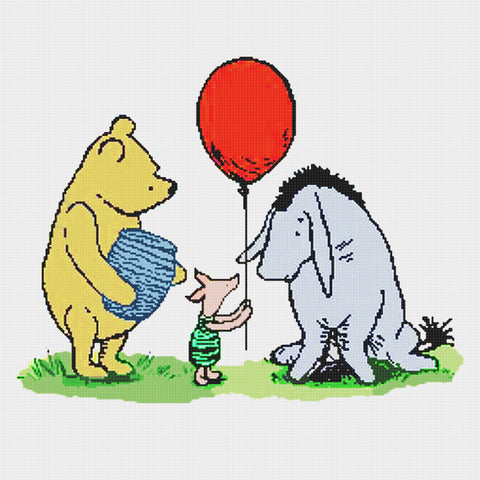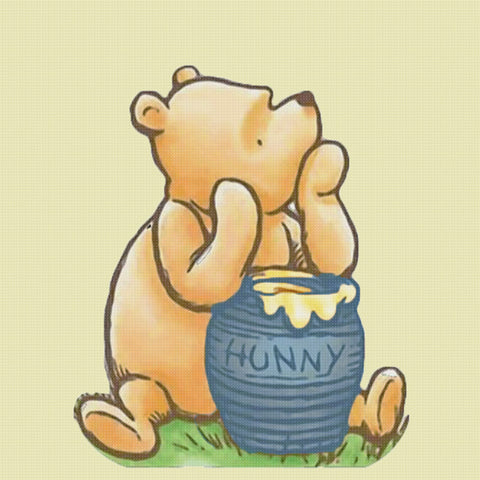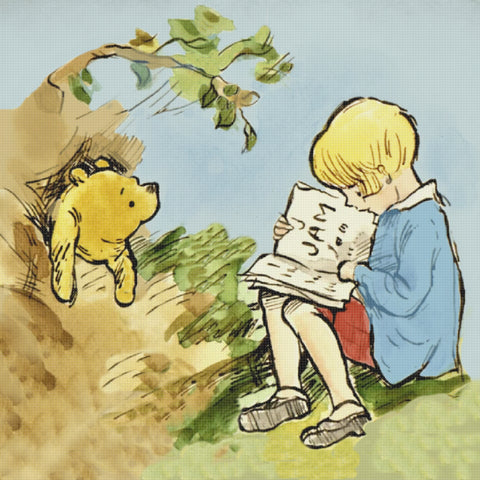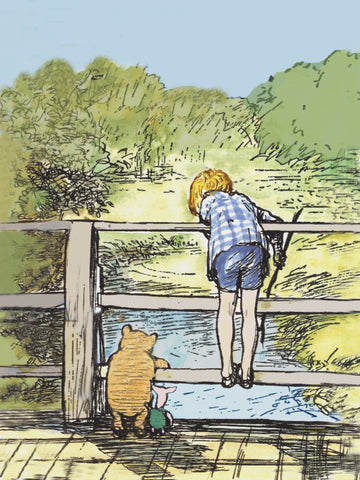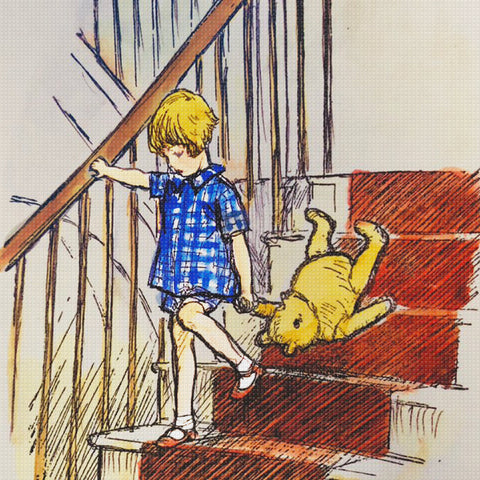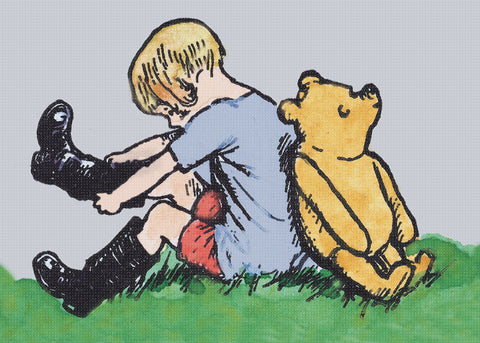-
This is a pattern that is used to sew and to create a counted cross stitch picture.
-
COUNTED CROSS STITCH PATTERN Charted for 14 count fabric and DMC Cotton Floss.
-
COUNTED CROSS STITCH PATTERN Charted for 14 count fabric and DMC Cotton Floss. Finished size is 14 inches (196 Stitches) by 10 inches (140 Stitches).
-
Chart/Patterns use up to 30 colors of floss. Full stitches only. No half stitches and no backstitching necessary.
-
We provide two charts both printed in black ink on bright white 11" by 17" paper. Chart #1 is a single page chart. Chart #2 (tired eyes) is a 4 page enlarged chart that eases eye strain.
This is a pattern that is used to sew and to create a cross stitch picture.
This is NOT a completed product. It is NOT a kit, it contains no floss or fabric.
This chart was inspired by the works of A.A. Milne.
Winnie-the-Pooh, is a collection of children's stories by A.A. Milne, published in 1926. Milne wrote the episodic stories of Winnie-the-Pooh and its sequel, The House at Pooh Corner (1928), for his young son, Christopher Robin, whose toy animals were the basis for many of the characters and whose name was used for the young boy who appears in the tales as the benign master of the animals.
The main character, Winnie-the-Pooh (sometimes simply called Pooh or Edward Bear), is a good-natured, yellow-furred, honey-loving bear who lives in the Forest surrounding the Hundred Acre Wood (modeled after Ashdown Forest in East Sussex, England). His companions are Eeyore, a gloomy gray donkey; Piglet, a timid pig; Owl, a pontificating bird; the meddlesome Rabbit; and Kanga, an energetic kangaroo whose inquisitive baby, Roo, lives in her pouch.
The stories are simply written, to appeal to young readers, and full of comic moments as well as silly verses. However, the work also is notable for its insights into human behavior, and Milne's characters are endearing but also complex. E.H. Shepard's original illustrations add to the charm of the book and helped make it a children's classic.


![[product_title] - Orenco Originals LLC Counted Cross Stitch](http://www.orencooriginals.net/cdn/shop/products/01a14x10PoohandEyoreSTITCHEDcopy_1024x1024.jpg?v=1672378473)
![[product_title] - Orenco Originals LLC Counted Cross Stitch](http://www.orencooriginals.net/cdn/shop/products/01a14x10PoohandEyoreSTITCHEDcopy_medium.jpg?v=1672378473)
![[product_title] - Orenco Originals LLC Counted Cross Stitch](http://www.orencooriginals.net/cdn/shop/products/OrencoOriginalsStitchPillow_6_713112f9-b326-4c41-b99d-8cfd10a5df5b_medium.jpg?v=1672378555)
![[product_title] - Orenco Originals LLC Counted Cross Stitch](http://www.orencooriginals.net/cdn/shop/products/OrencoOriginalsStitchFrame_1-Copy_87724a30-a916-4095-94be-94578ba157db_medium.jpg?v=1672378555)
![[product_title] - Orenco Originals LLC Counted Cross Stitch](http://www.orencooriginals.net/cdn/shop/products/OrencoOriginalsStitchPillow_1-Copy_a892f139-400c-4f7d-96af-bf32eb12bafa_medium.jpg?v=1672378555)
![[product_title] - Orenco Originals LLC Counted Cross Stitch](http://www.orencooriginals.net/cdn/shop/products/ChartExample-Copy-Copy-Copy_2_-Copy_f2db94f3-bd24-46ef-8d8a-11e846dbd991_medium.jpg?v=1672378555)
![[product_title] - Orenco Originals LLC Counted Cross Stitch](http://www.orencooriginals.net/cdn/shop/products/OrencoOriginalsStitchFrame_2_9b93c81c-4496-48ed-be2d-61b0a59260c6_medium.jpg?v=1672378555)
![[product_title] - Orenco Originals LLC Counted Cross Stitch](http://www.orencooriginals.net/cdn/shop/products/OrencoOriginalsStitchFrame_3-Copy_93088072-9e3f-4ee9-a5ff-16dd7d699c06_medium.jpg?v=1672378555)
![[product_title] - Orenco Originals LLC Counted Cross Stitch](http://www.orencooriginals.net/cdn/shop/products/OrencoOriginalsStitchFrame_4-Copy-Copy_medium.jpg?v=1672378555)
![[product_title] - Orenco Originals LLC Counted Cross Stitch](http://www.orencooriginals.net/cdn/shop/products/OrencoOriginalsStitchFrame_5_3f95e796-2700-45dd-90eb-d7a20ff62c4a_medium.jpg?v=1672378555)
![[product_title] - Orenco Originals LLC Counted Cross Stitch](http://www.orencooriginals.net/cdn/shop/products/OrencoOriginalsStitchFrame_6-Copy_15b9481a-91ac-4e16-a0f7-b463b2b32269_medium.jpg?v=1672378555)
![[product_title] - Orenco Originals LLC Counted Cross Stitch](http://www.orencooriginals.net/cdn/shop/products/OrencoOriginalsStitchFrame_7_690e135b-dc1f-4c23-8a4e-125e33244d17_medium.jpg?v=1672378555)
![[product_title] - Orenco Originals LLC Counted Cross Stitch](http://www.orencooriginals.net/cdn/shop/products/OrencoOriginalsStitchPillow_3-Copy_02e03a87-d882-4ec7-88c8-90b75c5f5c69_medium.jpg?v=1672378555)
![[product_title] - Orenco Originals LLC Counted Cross Stitch](http://www.orencooriginals.net/cdn/shop/products/ChartExample-Copy-Copy-Copy_1_-Copy_4bf90165-012d-4684-8c50-379c0ea18893_medium.jpg?v=1672378555)
